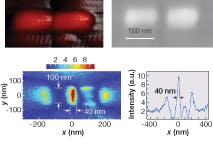MICROSCOPY: Plasmonic laser antenna sharpens nanovision
In August of this year, researchers at Harvard University (Cambridge, MA) reported research results that appear to address this conundrum directly. They successfully made use of plasmonic effects to integrate an optical antenna onto a laser diode. In doing so, they also concentrated the laser radiation down to dimensions that are an order of magnitude less than its wavelength.1
The Harvard surface-plasmon device consists of a dipole antenna in which two 130-nm-long and 50-nm-wide gold nanorods are separated by a 30 nm gap and integrated onto the facet of a commercial 830 nm laser diode (see Fig. 1). Laser excitation of surface plasmons in the gold nanorods generated enhanced and spatially confined optical near fields, and a spot size measuring 40 × 100 nm was obtained (see Fig. 2). Resonant dimensions for the optical-antenna gap and segments were obtained prior to fabrication by modeling optical-antenna structures using finite-difference time-domain software.
The Harvard team was from the Division of Engineering and Applied Sciences. It included Ertugrul Cubukcu and Eric Kort, graduate students in the Ken Crozier and Frederico Capasso research groups at Harvard. Their device appears to be the first integration of an optical antenna onto a laser, providing a platform that effectively combines plasmonics with near-field microscopy.
“The laser diode illuminates the antenna, exciting surface-charge oscillations or surface plasmons,” Crozier said. “This leads to an intense nanospot of light in the antenna gap.” The intensity of the spot is due to a capacitive effect between the gold nanorod facets that creates a huge electric field. In pulsed operation, the antenna can generate a peak intensity of more than a gigawatt per square centimeter.
The researchers believe that spot sizes of 20 nm should be possible and point out that the technology can be implemented in spectral regions ranging from the visible to the far-infrared, and can also be implemented using quantum-cascade lasers. Potential application areas include near-field optical microscopes, optical data storage, and heat-assisted magnetic recording.
REFERENCE
1. E. Cubukcu et al., Applied Physics Lett. 89, 093120-1 (2006).
Hassaun A. Jones-Bey | Senior Editor and Freelance Writer
Hassaun A. Jones-Bey was a senior editor and then freelance writer for Laser Focus World.

